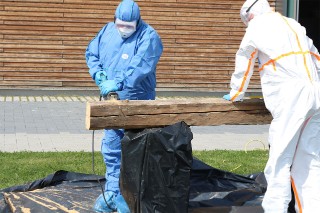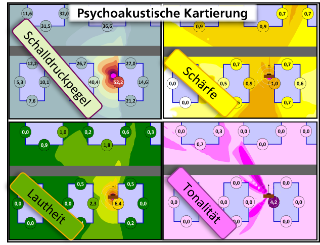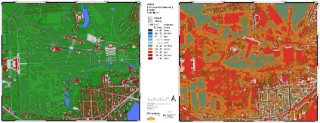In the technology project »Model-based development of the evaporator periphery«, the components adjacent to the evaporator are adapted so that newly developed evaporators can be profitably used in a heat pump. In order to operate the evaporator of a heat pump efficiently, certain boundary conditions must be met so that icing and defrosting as well as the equal distribution of air and refrigerant function correctly. These include that the air flow is optimally designed, that the refrigerant enters the evaporator in the correct state and that the ice slurry, which is formed in the drip tray during a defrost, can melt efficiently.
more infoProjects and References
-
-

Lärmemissionen von Wärmepumpen.
In the »MENESA« project, the three research institutes Fraunhofer ISE, Fraunhofer IBP and Fraunhofer IWU are working on methods to improve heat pumps with regard to vibrations and noise. The resulting methods allow structural-dynamic and acoustic aspects to be taken into account at an early stage in the development of heat pumps, so that low-noise operation can be achieved in a real operating environment.
more info -

Sawing work on a historic timber beam contaminated with lindane.
The CycloPlasma project combines an innovative adsorbent material and plasma technology to decontaminate wooden structures containing lindane and PCP. The CycloPlasma technique is a revolutionary concept when it comes to renovating and modernizing historical buildings. The method can be applied to all buildings in private and public ownership.
more info -

Visualisierung der Kennwerte Schalldruckpegel, Schärfe, Lautheit und Tonalität.
Psychoacoustics help to predict sound immission so that the actually perceived noise load can be mapped with a view to improving noise control.
more info -

Model of Roggersdorf Church.
In the project "Climate for Culture" the influence of climate change on cultural assets in Europe is determined with 27 partners.
more info -

Green roofs increase the proportion of unsealed land in urban areas. Rainwater can seep into them and is stored instead of running off mostly as surface water.
In this project, the existing range of test facilities and simulation options at Fraunhofer IBP are supplemented in order to record rainwater retention capacity of green roofing structures.
more info -

The structure of cattails makes them ideal for use in building materials.
Development and utilization of an innovative organic-based building material made of cattail and geopolymer.
more info -

Individual modular elements.
There is a lack of suitable depots that meet the requirements of sustainability and energy efficiency as well as those of conservation.
more info -

Possible solutions for using a building with wind-powered heating 2.0 with a large hot water storage tank (A), building component activation (B) and a central high-temperature stone storage tank (C).
The aim of the research study is to develop concepts for »Buildings heated by wind-power«, which are heated during periods of strong wind only.
more info -

Sanssouci Palace Park - input data for the PALM-4U simulation (left) and simulated heat load on a hot summer's day (right).
Cultural assets are critical socio-cultural infrastructures whose services contribute to Germany's economic development and competitiveness and promote the community. However, the increase in extreme weather events due to climate change poses a threat to these infrastructures, such as historic buildings & gardens and cultural landscapes. The BMBF-SiFo project “KERES” therefore studied future extreme weather events and their effects on our cultural heritage in Germany, and used models to examine these scenarios.
more info